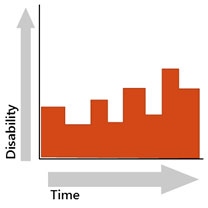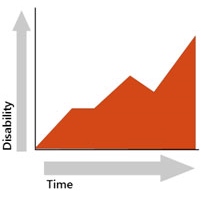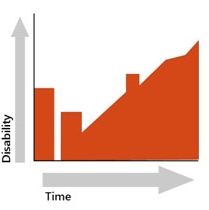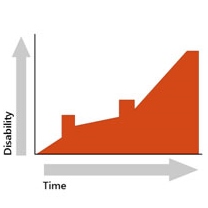Multiple Sclerosis

What is multiple sclerosis? How does multiple sclerosis happen?
Multiple sclerosis is the disease when the human central nervous system (brain and spinal cord) produces an abnormal immune response leads to inflammatory diseases of the nervous system and then "myelin" disruptive. Myelin is like plastic leather wire insulation isolation function, so that different neural pathways signals do not interfere with each other, can also accelerate nerve signal conduction. When the myelin is damaged, the transmission of nerve messages will slow down or even stop. Multiple sclerosis is the combination of different symptoms when generated massive demyelination of myelin occur at the different areas of central nervous system.
Multiple sclerosis is not a hereditary disease. The cause is still unknown and there is no clinical indicators can predict the onset of the disease. Early treatment to help control disease activity is the main goal of treatment widely now1.
What are the types of multiple sclerosis?
Types of multiple sclerosis varies and can be categorized into the following four types1.
1. Relapsing-remitting type:
The symptoms can somehow lessen after the relapsing of the disease, but can not completely recover. The disease will become more serious along with the increase in the number of relapses. Most of the patients belong to this type of repeated attacks, about 45% to 50% of total patients.

2. The primary progressive type:
About 10% to 15% multiple sclerosis patient gradually deteriorate since the beginning of the diagnosis, with no significant land seizure, restoration, and are more difficult to control.

3. The secondary progressive type:
Such patients are similar to the relapsing-remitting type and can be restored after the onset in the beginning. However, after the onset of symptoms, it will become increasingly serious. About 50% of patients with relapsing-remitting type can turn into the secondary progressive type patients in 10 years without proper treatment.

4. Progressive relapsing:
This type of patients may recover or partially recover during the recurrence of symptoms, but the condition will continue to deteriorate during the relapse.

What are the symptoms of multiple sclerosis?
The main clinical manifestations of neurological deficits, most commonly occur within minutes to hours. Early symptoms of the disease according to its injured parts varies. If the optic nerve is damaged, there will be visual impairment problems; if the brain is damaged, impaired concentration, cognitive impairment; if cerebellar damage, then there will be language barriers and coordination 1.
Diagnosis and Treatment
Why early diagnosis and early treatment for multiple sclerosis is important?
If multiple sclerosis is early-diagnosed and treated, it can reduce demyelination and avoid nerve cell damage. Because multiple sclerosis is a progressive disease, more attacks cause nerve cell injury and have greater chance of irreversible damage. The goal of treatment is to prevent attacks or to slow down the severity of the attacks to reduce demyelination 1,2,3.
What drugs to treat multiple sclerosis?
1. Acute or exacerbation of treatment:
Injection / oral steroids for acute or exacerbation, can reduce nerve inflammation and help restore neurological function, but can not cure multiple sclerosis.
2. The course of the disease treatment: delay disease progression, and reduce nerve damage caused by the attack.
(1) First line of treatment
Interferon-beta for injection
Copaxone for subcutaneous injection
(2) Second-line treatment
Tysabri for injection
Gilenya for oral
Reference
2.CH Polman, et al. A Randomized, Placebo-Controlled Trial of Natalizumab for Relapsing Multiple Sclerosis. N Engl J Med 2006; 354:899-910.
3.H Butzkueven, et al. Efficacy and safety of natalizumab in multiple sclerosis: interim observational programme results. J Neurol Neurosurg Psychiatry published online February 14, 2014.



